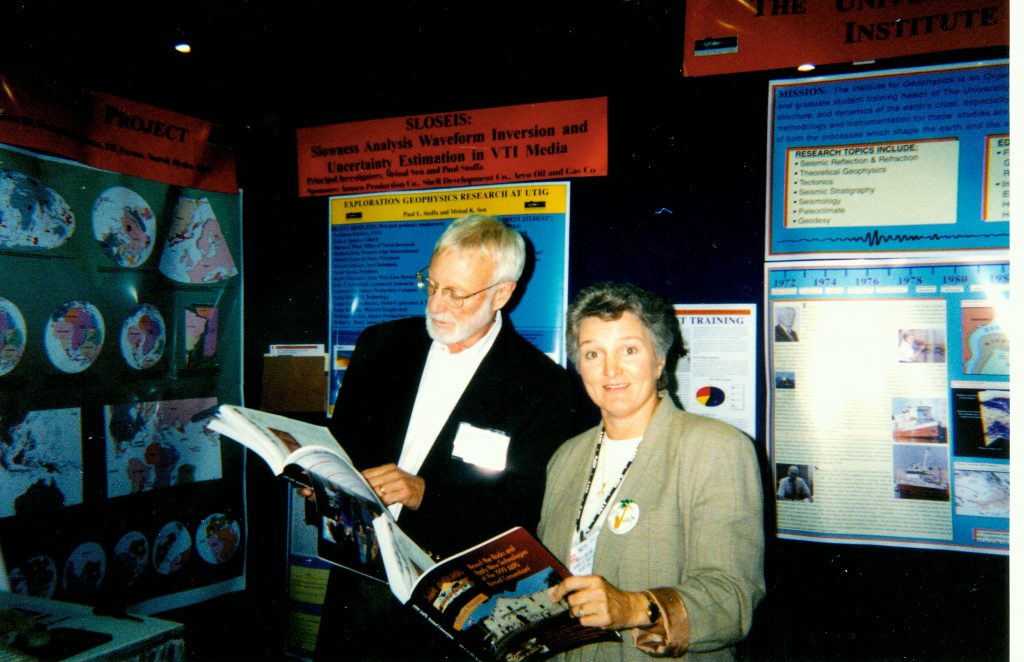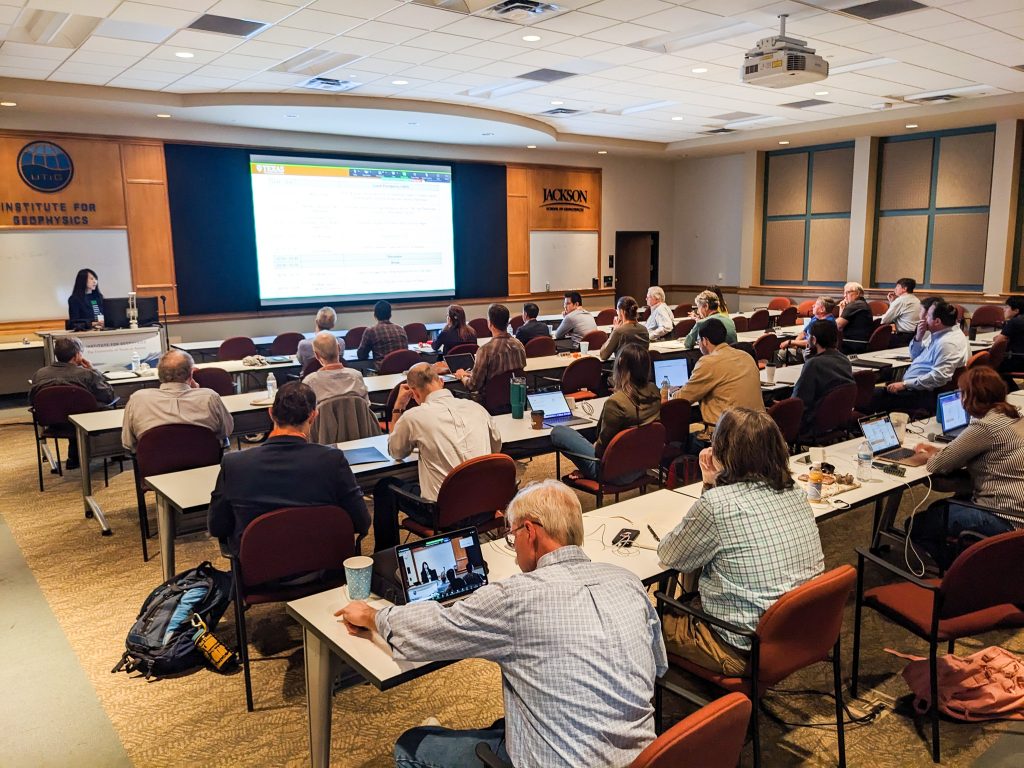

The University of Texas at Austin is celebrating a long-running research partnership with the energy industry that has generated 30 years of scientific discovery about the Gulf of Mexico.
Founded in 1995 at the University of Texas Institute for Geophysics, the Gulf Basin Depositional Synthesis (GBDS) program turns industry data into geologic maps for use by academic researchers and industry scientists.
The partnership provides its industry partners with geologic knowledge that is important for energy exploration and, more recently, the energy transition.
For three decades GBDS scientists have been the go-to regional experts for oil and gas exploration in the Gulf of Mexico, said GBDS Co-Director John Snedden.
“We’re positioning ourselves for the energy transition by showing how the Gulf of Mexico can be a hub for carbon storage, geothermal, critical minerals and hydrogen storage,” he said. “The same maps we’ve developed for conventional exploration are now being used for those energy transitions.”
The anniversary comes as UT Austin President Jay Hartzell has declared UT “The Energy University.” GBDS’s success has been no accident, said UTIG Director Demian Saffer.
“GBDS and its leaders have been creative in delivering sustained value to our industry sponsors and adapting to meet the needs of that partnership,” Saffer said. “It’s an impressive model and forward-looking approach that is poised to continue delivering scientific and industry value well into the future.”

At its core, GBDS is a research program that answers scientific questions about the Gulf of Mexico’s origin and geologic evolution.
“Our motto is solving scientific problems with industry data, while at the same time addressing industry interests,” Snedden said.
Scientific highlights include documenting geologic evidence for global tsunamis after the dinosaur-killing asteroid impact. GBDS scientists also conducted notable science on later extinction events (see Shaping Science and Energy) that acidified global oceans, and analyzed drilling samples to tell the tale of how an ancient river in Chiapas, Mexico laid the foundation for one of the largest recent oil and gas discoveries in the southern Gulf.
For the energy industry, the maps and accompanying database have long been a familiar reference guide for company geologists, who use them frequently in conference presentations and management meetings. Companies use them to understand the geologic background of the region in which they’re operating. This allows them to make better-informed decisions about where new energy resources may be found.
The same information is turning out to be very useful for companies exploring sites in the Gulf of Mexico for carbon storage, geothermal energy, critical minerals and hydrogen storage.
A large part of the success of the GBDS maps comes from the hard work of students from the Jackson School of Geosciences. They collated industry data and processed it into the maps that make up the GBDS “atlas” and ArcGIS database. UTIG is part of the Jackson School.

In recent years GBDS has ramped up student recruitment, especially among undergraduates, said program co-director Mike Sweet. The skills students acquire working on building the GBDS maps frequently help students obtain industry jobs and prepare them for graduate school.
“It’s gratifying to see them moving out and developing their careers based on their experience with us,” said Sweet, who himself had a long career in industry after he earned a graduate degree in geology at UT while studying under Professor Emeritus Gary Kocurek, who recently passed away.
GBDS students and researchers will present updates to the latest geologic atlas of the Gulf of Mexico at the GBDS annual sponsor meeting. The meeting will take place Jan. 14-15, 2025, at UTIG in Austin, Texas. A public reception will be held to mark the program’s 30th anniversary from 5-7 p.m. on Jan. 14.

SHAPING SCIENCE AND ENERGY
Since 1995 the Gulf Basin Depositional Synthesis program at the University of Texas Institute for Geophysics has been an invaluable resource for industry geologists and academic researchers alike. At its core is an ArcGIS database of seismic images and drilling samples and an atlas of geologic maps that tell the story of the Gulf of Mexico’s evolution from an ancient shallow sea to its “super basin” status today.
Scientific highlights include:
- The creation of 500 maps that make up the GBDS Atlas.
- Publishing 100 GBDS-led research papers in peer-reviewed journals.
- Discovering that just prior to the Chicxulub asteroid impact that wiped out the dinosaurs, 96% of the Gulf of Mexico seafloor was made up of chalky carbonates accumulated during a long period of warm climate and high sea levels. When the asteroid struck, this material directed the strength and amplitude of the subsequent global tsunami. Rocks from the seafloor are found in the thin, geologic layer that marks the day the Cretaceous ended.
- Collaborated with Professor Danny Stockli, the chair of the Jackson School’s Department of Earth and Planetary Sciences, to demonstrate that an ancient river in Chiapas, Mexico, carried sediments into the Zama basin 10 million years ago, depositing the reservoir for a massive oil and gas field discovered recently in the southern Gulf.
- Finding that the Gulf of Mexico’s unique geology sheltered the basin from an ancient bout of global warming 56 million years ago known as the Paleocene-Eocene Thermal Maximum, which acidified oceans and caused marine life extinctions elsewhere.
STANDING THE TEST OF TIME
Through planning and vision GBDS has survived and thrived through roller coaster oil prices, economic and political crises, and a global pandemic. GBDS expanded its database and atlas in stages, moving from Cenozoic deepwater, to Mesozoic geology, to much younger geology in shallower waters, and now onshore regions that are ideal for carbon storage. This strategic focus has delivered basin-wide scientific insights and now promises an abundance of opportunities for energy transition projects.
Financial highlights include:
- To date, GBDS has brought The University of Texas at Austin $16,868,485 in industry funding.
- Through a $30,000 annual membership, each partner receives the benefit of $1 million in research funded by the consortium.
- GBDS has funded 20+ graduate students (master’s and doctoral) and about 50 undergraduate research projects.
- Two postdoctoral researchers have been funded through GBDS. These include Chris Lowery, now assistant professor at UTIG, who conducted seminal work on the recovery of life after the dinosaur extinction, and Zach Sickmann, now assistant professor at The University of Texas at Dallas, whose research on sediment provenance is forming the basis of a new way to tackle illegal sand mining.
